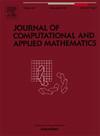A conforming virtual element framework for the time-fractional semi-linear reaction–diffusion equation on polygonal meshes
IF 2.6
2区 数学
Q1 MATHEMATICS, APPLIED
Journal of Computational and Applied Mathematics
Pub Date : 2025-09-25
DOI:10.1016/j.cam.2025.117100
引用次数: 0
Abstract
This article presents the virtual element method for solving a two-dimensional time-fractional semi-linear reaction–diffusion equation with a fractional derivative of order in time. The methodology is based on three fundamental technical components: a fractional version of the Grünwald–Letnikov approximation, a discrete maximal regularity property, and the regularity theory associated with non-linearity. We prove the well-posedness of the discretized scheme developed for the solution of the time-fractional reaction–diffusion equation with a Lipschitz-continuous nonlinear term. The fully discrete scheme inherently maintains stability and consistency by leveraging the discrete maximal regularity and the elliptic projection operator. The convergence in the norm and semi-norm is validated by numerical results over regular Voronoi, distorted hexagons, and non-convex polygon mesh configurations, underlining the practical effectiveness of the proposed scheme. The numerical examples illustrated are important real time applications of the time-fractional nonlinear partial differential equations.
多边形网格上时间分数阶半线性反应扩散方程的一致虚元框架
本文给出了求解二阶分数阶α∈(0,1)的二维时间分数阶半线性反应扩散方程的虚元法。该方法基于三个基本技术组成部分:分数版本的gr nwald - letnikov近似,离散最大正则性,以及与非线性相关的正则理论。证明了具有lipschitz -连续非线性项的时间分数阶反应扩散方程离散化格式的适定性。完全离散格式利用离散极大正则性和椭圆投影算子固有地保持稳定性和一致性。通过正则Voronoi、畸变六边形和非凸多边形网格构型的数值结果验证了该方案在L2范数和H1半范数上的收敛性,强调了该方案的实用性。所示的数值例子是时间分数阶非线性偏微分方程的重要实时应用。
本文章由计算机程序翻译,如有差异,请以英文原文为准。
求助全文
约1分钟内获得全文
求助全文
来源期刊
CiteScore
5.40
自引率
4.20%
发文量
437
审稿时长
3.0 months
期刊介绍:
The Journal of Computational and Applied Mathematics publishes original papers of high scientific value in all areas of computational and applied mathematics. The main interest of the Journal is in papers that describe and analyze new computational techniques for solving scientific or engineering problems. Also the improved analysis, including the effectiveness and applicability, of existing methods and algorithms is of importance. The computational efficiency (e.g. the convergence, stability, accuracy, ...) should be proved and illustrated by nontrivial numerical examples. Papers describing only variants of existing methods, without adding significant new computational properties are not of interest.
The audience consists of: applied mathematicians, numerical analysts, computational scientists and engineers.

 求助内容:
求助内容: 应助结果提醒方式:
应助结果提醒方式:


